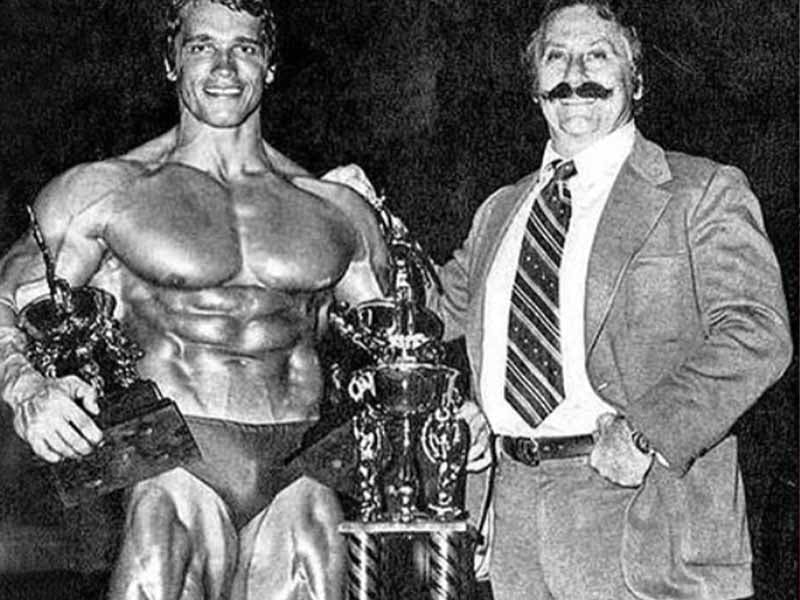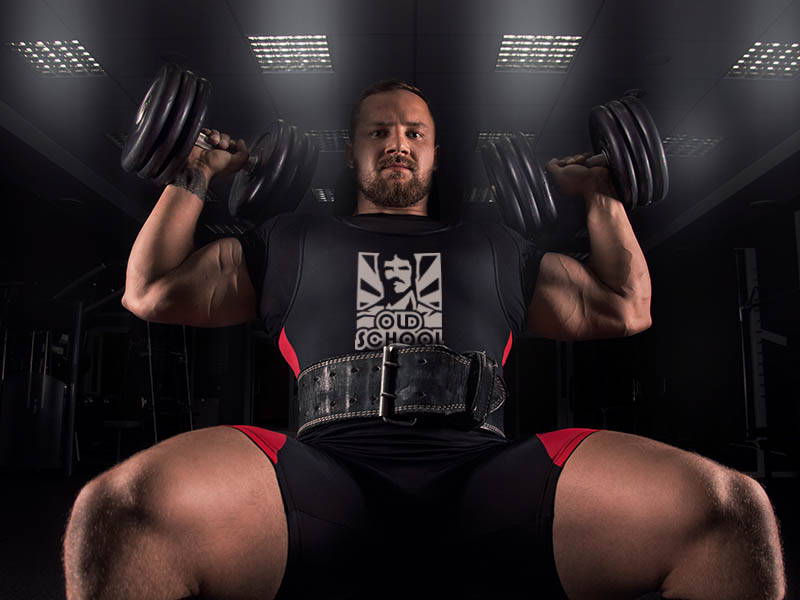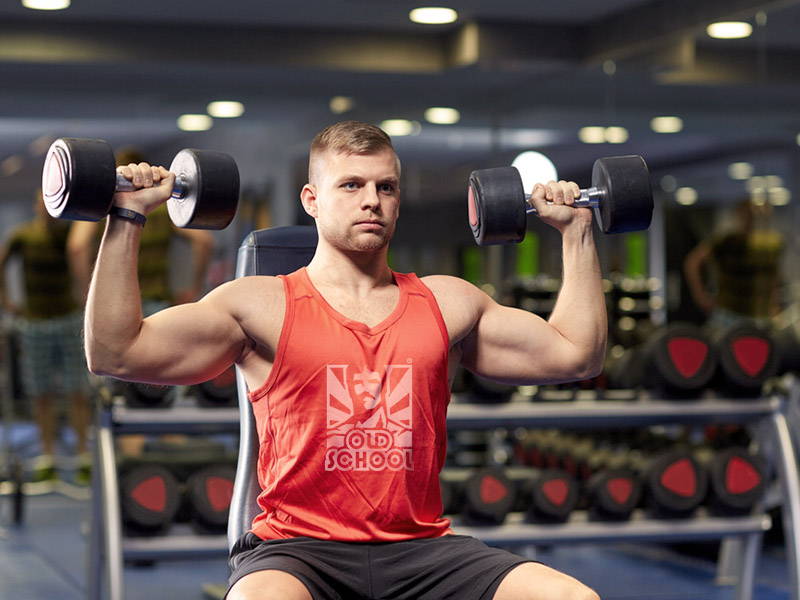
How To Do The Arnold Press: Form, Tips, & Workout
Key Takeaways
- The Arnold press is a form of shoulder press named after Golden Era legendary bodybuilder Arnold Schwarzenegger.
- Working all three heads of the deltoid muscles, the Arnold press is a fantastic move to bring impressive gains. Proper form is required to avoid rotator cuff injury as this exercise works through the full range of motion.
- Keep reading to learn the proper form for the Arnold press, including muscles worked, ways to include it in your workout routine and tips for success.
Did Arnold Schwarzenegger invent the Arnold press? You bet he did.
Yes, THAT Arnold, seven-time Mr. Olympia champ Arnold Schwarzenegger. If you’ve been following along in the Mr. Olympia recaps, you can see the results of his tedious workout routine.

Arnold may have won the genetic lottery, but he still had to work hard in the gym. He spent hours working his physique, he was regularly seen in the gym two or more times a day. His dedication provided great reward for this bodybuilding legend.
While shoulder presses are nothing new, the Arnold press is a technique created by the Austrian Oak. Using this method, he was able to build even more definition in his deltoids, pleasing judges and fans at competitions.
Today is all about the Arnold Press:
- What muscles it works
- Benefits
- How it’s different from the shoulder press
- How to perform it correctly
- Tips for lifting success
- How to add this exercise to your existing workout routine
Arnold Press: Muscles Worked
The Arnold Press works all three heads of the shoulder at the same time. That means the anterior, middle, and posterior deltoids are all getting the benefit from just one move.
Why is that a big deal? Well, most men get plenty of front delt action, but not so much for the middle and back. The medial head provides width and thickness to the shoulders, while the back head improves posture and stabilizes the shoulder joint.

The Arnold press is also called the Scott Press because it helped Larry Scott build impressive shoulder definition. What was once his weakest point was now one of his proudest muscle groups, and for good reason.
The Arnold press is so effective, it’s still used as a baseline shoulder exercise today. Now, that doesn’t mean you need to throw all the delt head isolation exercises out the window. Lateral raises, shoulder presses, and the like can still be in your rotation.
However, if you don’t have much time at the gym and you want a quality shoulder day with one workout, this is it. If you have dumbbells at home, you can even do the Arnold press without setting foot in the gym.
Benefits of the Arnold Press
If you choose to include the Arnold press as part of your shoulder workout, you can expect some benefits:
- Improved posture
- Hypertrophy on all three deltoid muscle heads
- Longer time under tension for bigger and faster gains
- Improved pulling muscle power (heavier deadlifts, rows, farmer’s carry, etc)
- The ability to bust through strength plateaus in other press exercises
Even with the benefits, there is still a slight chance of injury compared to other presses. You’ll see why when we show you the proper form for this move. If you have a current or past shoulder injury, the Arnold press may not be right for you.
Before we get into the proper form for the Arnold press, let’s go over how this differs from other presses.
Arnold Press vs Shoulder Press
Most shoulder presses are the same basic form with differences in stance, grip and certain movements. What makes the difference between the Arnold press and the shoulder press?

First, the shoulder press, also called the overhead press, can be done with dumbbells or a barbell. The Arnold press is done with dumbbells because the arms and shoulder rotate during the movement.
Second, the elbow position is different in the Arnold press compared to the overhead press. This is because of the rotation required to complete the final phase, for which this specific press was created.
Third, if you’ve never done the Arnold press before, you won’t be able to lift as heavy as the overhead press. Rather than lifting straight up without shoulder rotation, the Arnold press requires movement, preventing heavier lifts. Unless your ego is the size of your future gains, this shouldn’t really matter.
Finally, the shoulder press works the front and medial delts, without as much activation of the back delts. The superior total delt activation gives the Arnold Press an edge over the overhead press.
With that said, there is more room for shoulder injury, including shoulder impingement (rotator cuff injury). If you notice even a slight pain in your shoulder, stop the Arnold press immediately.
Focus instead on strengthening your middle and upper back muscles before you try again. Check out the tips section for ways to improve and strengthen the shoulders, traps, and upper back.
Want to learn how to do a proper overhead press? We’ve got detailed instructions right here.
Ready to get started on the perfect form of the Arnold press?
Arnold Press: Proper Form
The Arnold press is usually performed when seated, so you’ll need an adjustable bench and dumbbells. Remember, you don’t want to go too heavy with this particular shoulder press.
Choose a lighter weight to practice the rotation of the Arnold press. Once your form is flawless, you can add more weight. Just don’t go crazy because if you injure your shoulder, you won’t be doing shoulder presses any time soon.

The seated Arnold press is great for someone just starting out or who has lower back problems. If not, you can absolutely do this standing as well, which will activate the upper back and core muscles more.
Seated Arnold Press Instructions
- Set the bench to 90 degrees and grab your dumbbells.
- Sit down with your back against the raised bench pad. Keep your back straight and core engaged throughout the move.
- Hold a dumbbell in front of you with each hand, elbows tucked to the side. Keep your palms facing you so the dumbbells are right around shoulder level. The length of your limbs will determine where the dumbbells fall at your upper torso.
- Begin to lift the dumbbells, moving your elbows to rotate the weight out, until your palms are facing away from you. Inhale as you push the dumbbells up.
- Continue to press the dumbbells up, keeping your shoulder blades down and back.
- Exhale as you slowly bring the dumbbells back down, rotating again to bring them back to the starting position.
The ascent and descent should both be done in a steady and controlled motion. To get the move right and avoid injury, try it a few times without any weight first.

Complete 8 to 10 reps for two sets, just to start. Continue perfecting the Arnold press until you can complete 10 to 12 reps and three sets. Take up to 90 seconds to rest between sets as needed.
Avoid increasing the weight until you can do the full three sets without breaking form. You want your Arnold press to be flawless so you can add heavy weights without risk of injury.
Tips for Arnold Press Success
The Arnold press requires precision rotation so as not to cause injury to the shoulder.

These tips can help you succeed with the proper form so you can start lifting heavier without fear.
- Keep your neck soft and avoid letting your head move forward or back. You want your neck to stay neutral and not move as you perform the press.
- Feeling pressure in your traps or neck when performing the Arnold press? This could be a sign of weak shoulder flexion or thoracic spine extension. Here are a few moves you can do to improve thoracic spine mobility. These stretches and exercises can help with shoulder mobility.
- Stopping the ascent just below elbow lockout will improve time under tension, making the deltoids work even harder.
- Keep your core and lower back engaged throughout your sets to avoid arching your back. If you’re having trouble (especially with the standing Arnold press), then your weight is too heavy.
- If you notice pain or discomfort at the top when locking out the elbows, you could be lacking upward shoulder mobility. Scale back and work on building up your shoulder mobility using some of the exercises linked above.
Adding the Arnold Press to Your Workout
Want some ideas on ways to include the Arnold press into your workout? You have some options depending on if you want to incorporate them into your upper or lower body workout.
Upper Body Workout
The Arnold press could be added as a superset with your shoulder or chest day. If you’re including other shoulder exercises, use the Arnold press as a finishing movement.

You can also incorporate the Arnold press as a warm-up exercise for shoulder day. Grab lightweight dumbbells and bust out a couple of sets to get your shoulder nice and warm. Then you can add them back at the end, but this time go heavier with the weights.
Lower Body Workout
If you’d rather include the Arnold press in your lower body workout, here are some suggestions.
If you’re strictly working the lower body, the Arnold press is a great way to warm up the core and lower back. Just like the upper body workout, you can use light weights for your warm up.

Perform the standing Arnold press, using slow and controlled movements, while concentrating on your core and back tightness. When you’re done, do some jumping jacks and a plank to finish your warm up.
Full Body Workout
You can also create a full-body workout with just a few moves if you’re short on time.
Use a compound lower body exercise like lateral lunges or squats to blast your muscles from the core down.
Use the Arnold press to work the muscles from the core up for a quick in-and-out full-body routine.
Final Thoughts
The Arnold press was made famous by the man who tweaked the shoulder press, Arnold Schwarzenegger. This ultimate Golden Era legend had some massive shoulder definition back in the day from utilizing this move.
Unlike other shoulder press variations, the Arnold press hits all three heads of the shoulder muscle. If you’re in a hurry, you can use this one move to get in a quality shoulder day without any filler.
The longer time under tension breaks the muscle fibers down quicker than other compound shoulder exercises. Less is more with this move, with both weight and sets. Shoulder injury is higher because of the full range of motion from the rotation, so proceed with caution.
Protect your bones and joints from injury with Vintage Bend™. Our proprietary formula also fights inflammation, helping to speed up recovery to keep pressing like Arnold.
What are your thoughts on the Arnold press? Do you prefer a different exercise to hit all heads of the deltoids? We’d love it if you’d share your thoughts in the comments below.







![Phil Williams – Training At Gold’s Gym – Bodybuilding Legends Podcast with John Hansen [S7E4]](https://www.oldschoollabs.com/wp-content/uploads/2020/10/Phil_Williams_Thumbnail_Optimized.png)
![Roger Callard – Bodybuilding Legends Podcast With John Hansen [S1E2]](https://www.oldschoollabs.com/wp-content/uploads/2020/08/Roger-Callard-Thumbnail-Optimized.png)
![Chris Aceto – Bodybuilding Legends Podcast with John Hansen [S7E7]](https://www.oldschoollabs.com/wp-content/uploads/2020/06/Chris-Aceto-Thumbnail2.png)